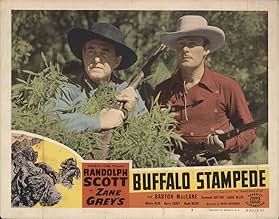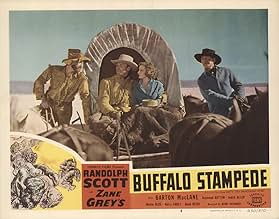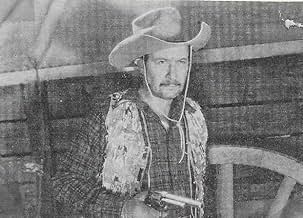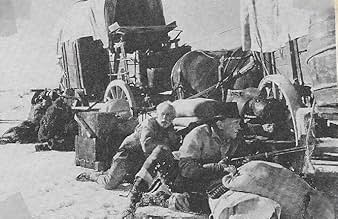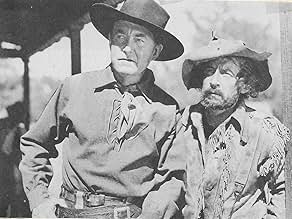Füge eine Handlung in deiner Sprache hinzuBoth Sprague and Jett and their crews are hunting buffalo. Doan is with Sprague and is looking for the Jett outfit where his girlfriend Milly is being held against her will.Both Sprague and Jett and their crews are hunting buffalo. Doan is with Sprague and is looking for the Jett outfit where his girlfriend Milly is being held against her will.Both Sprague and Jett and their crews are hunting buffalo. Doan is with Sprague and is looking for the Jett outfit where his girlfriend Milly is being held against her will.
- Regie
- Drehbuch
- Hauptbesetzung
Blanche Friderici
- Mrs. Jane Jett
- (as Blanche Frederici)
Fred Burns
- Man Exiting Store
- (Nicht genannt)
Frank Ellis
- Henchman
- (Nicht genannt)
Francis Ford
- Frank
- (Nicht genannt)
Billy Franey
- Baldy
- (Nicht genannt)
Empfohlene Bewertungen
The stampede scenes were filmed at the Lamar Valley Buffalo Ranch in Yellowstone National Park.
There were only 24 buffalo left in the world on 1901, so Congress appropriated funds in 1902 to prevent their extinction and the few wild buffalo in Yellowstone were gradually mixed with some ranch animals from Texas and Montana.
The park rangers in the past would sometimes stampede the herd for movies and visitors.
There are now 3,500..4,000 buffalo in YNP, but any that wander outside the boundaries are shot or rounded up and sent to slaughter.
There were only 24 buffalo left in the world on 1901, so Congress appropriated funds in 1902 to prevent their extinction and the few wild buffalo in Yellowstone were gradually mixed with some ranch animals from Texas and Montana.
The park rangers in the past would sometimes stampede the herd for movies and visitors.
There are now 3,500..4,000 buffalo in YNP, but any that wander outside the boundaries are shot or rounded up and sent to slaughter.
Buffalo stampedes... Indian attacks... Plundering bandits... Doan braved them all when he rode into the badlands... and rode out with a beautiful girl!
Both Sprague, Jett and their crews are hunting buffalo. Doan (Randolph Scott) is with Sprague crew and is looking for the Jett outfit where his girlfriend Milly is being held against her will. In addition to the thieving Jett who is stealing Sprague's furs, the Indians are gathering to attack all the white buffalo hunters.
Thundering Herd is quite a raw and primitive western which has some drama and conflict, rugged scenery and the characters -the Jetts- are rather primitive and uncouth degenerates. They do come across real as does the landscape and experiences. There's some good camera angles - but it can be a bit ponderous and dull.
Both Sprague, Jett and their crews are hunting buffalo. Doan (Randolph Scott) is with Sprague crew and is looking for the Jett outfit where his girlfriend Milly is being held against her will. In addition to the thieving Jett who is stealing Sprague's furs, the Indians are gathering to attack all the white buffalo hunters.
Thundering Herd is quite a raw and primitive western which has some drama and conflict, rugged scenery and the characters -the Jetts- are rather primitive and uncouth degenerates. They do come across real as does the landscape and experiences. There's some good camera angles - but it can be a bit ponderous and dull.
This very early film in Scott's career is the only one in which I've seen him sporting a pencil moustache(or any facial hair). Sometimes, I wondered if I was looking at Brian Donlevy, not realizing how much more they look alike with the moustache factor thrown in... Buster Crabbe is listed near the top of the credits, but only appears in the first segment, as a stage driver. Clearly, his brief appearance was meant to attract more female viewers...Harry Carey, a top cowboy draw during the silent era, has now been relegated to supporting roles, playing Clark Sprague, owner of the Sprague trading post, and bison shooting outfits. John Wayne had great respect for Carey's typical portrayal of westerners. Two of Carey's last film parts were in the Wayne-starring "Angel and the Badman" and "Red River"... Noah Beery played Randall Jett, boss of a hide- thieving buffalo shooting outfit.He and his more famous brother, Wallace, often played heavy villains...Jett's bossy, plain -looking, wife, Jane, is played by Bianche Friderici, who mostly played similar roles in other films...Judith Allen is the tomboyish Milly Fayre, stepdaughter of the Jetts, but with a bad relationship with both. She needs a good man(Randy's character) to rescue her from her intolerable life.
Randy's character, an experienced bison hunter, is a new hire for Sprague. Clearly, he has had a prior romantic relationship with Milly, as she jumps on a stage from her horse, looking for him. Later, they meet in the bush and plan to be married that night.But Randell catches her trying to ride out of the Jett camp, and she is put under guard. He has an incestuous relationship with her. Randy later catches up with the Jetts, on the move, but is wounded and knocked out trying to rescue Milly. The Jetts capture two Sprague wagons filled with hides.Later, the Sprague camp will be threatened by a bison stampede and a large 'Indian' war party. In contrast, the Jetts don't suffer from the bison, 'Indians', nor a reprisal from the Spragues. They are looking forward to more lucrative hide thievery during the early winter, as hide wagons get bogged down in deep snow.(Winter bison hides brought more money, as they were thicker-haired).But just then, as things are looking desperate for the Spragues, disaster hits the Jetts(see the film to find out their demise).
At the time this film was made, there were still only a relatively small number of American bison. Hence we didn't see any actual killings of bison, only stock footage of them being chased. In addition to the domestic market, there was a large European market for the hides at this time. They were especially valued as making a superior leather used as the belts for transferring steam power to machinery, as well as for personal items, such as hats, coats, boots and handbags.After the flesh disappeared, hunting parties returned to their killing fields to gather the bones, which were shipped east to make fertilizer and other products. Ironic that the meat, the most valued part of bison today, was the least valued under the technological conditions of those times(no refrigeration, no good substitute for machinery belts).
You may have noticed some rugged country in the foreground(especially the stage run) and background during parts of this film. Much of the action was filmed in the rugged Alabama Hills, near Lone Pine, with the high Sierras in the background. This was a favored location for filming many westerns, including most of the Hopalong Cassidy series. The often rounded granite boulders and monoliths are geologically similar to the granite in the Sierras, and represent the peaks of granite bodies buried within the sediments of Owens Valley.
Randy's character, an experienced bison hunter, is a new hire for Sprague. Clearly, he has had a prior romantic relationship with Milly, as she jumps on a stage from her horse, looking for him. Later, they meet in the bush and plan to be married that night.But Randell catches her trying to ride out of the Jett camp, and she is put under guard. He has an incestuous relationship with her. Randy later catches up with the Jetts, on the move, but is wounded and knocked out trying to rescue Milly. The Jetts capture two Sprague wagons filled with hides.Later, the Sprague camp will be threatened by a bison stampede and a large 'Indian' war party. In contrast, the Jetts don't suffer from the bison, 'Indians', nor a reprisal from the Spragues. They are looking forward to more lucrative hide thievery during the early winter, as hide wagons get bogged down in deep snow.(Winter bison hides brought more money, as they were thicker-haired).But just then, as things are looking desperate for the Spragues, disaster hits the Jetts(see the film to find out their demise).
At the time this film was made, there were still only a relatively small number of American bison. Hence we didn't see any actual killings of bison, only stock footage of them being chased. In addition to the domestic market, there was a large European market for the hides at this time. They were especially valued as making a superior leather used as the belts for transferring steam power to machinery, as well as for personal items, such as hats, coats, boots and handbags.After the flesh disappeared, hunting parties returned to their killing fields to gather the bones, which were shipped east to make fertilizer and other products. Ironic that the meat, the most valued part of bison today, was the least valued under the technological conditions of those times(no refrigeration, no good substitute for machinery belts).
You may have noticed some rugged country in the foreground(especially the stage run) and background during parts of this film. Much of the action was filmed in the rugged Alabama Hills, near Lone Pine, with the high Sierras in the background. This was a favored location for filming many westerns, including most of the Hopalong Cassidy series. The often rounded granite boulders and monoliths are geologically similar to the granite in the Sierras, and represent the peaks of granite bodies buried within the sediments of Owens Valley.
It's not too bad, but the good cast builds up expectations for this Western that are not really fulfilled. The story is just fair, and only the occasional good action scenes keep it going. It stars Randolph Scott, and has a good supporting cast that includes the likes of Harry Carey, Buster Crabbe, and more. The story has quite a bit going on, most of it focusing on rival groups of buffalo hunters. A lot happens, but much of the time it doesn't seem to fit together that well, and there are some slow stretches that could easily have been shortened or omitted. It's worth a look for the cast if you like older Westerns, but don't expect too much.
Action galore within a well-crafted and beautifully presented story make this one of the very best B westerns ever made.
Randolph Scott's mustache is rather jarring, to those of us who have never seen him with one, but he gives an excellent and athletic performance, joined by one of the finest casts ever assembled in a B western.
Bad guys are really bad, with Noah Beery giving one of his best performances as the worst of the bad guys ... although Mrs. Bad Guy is about as rough and evil as any woman I've ever seen in a B western.
This is not only brilliant story-telling, but it is brilliant acting.
And brilliant directing.
Henry Hathaway surpasses other possibly better-known and more highly regarded directors with his moving camera and his shots of moving horses and wagons and buffalo. (His last years, though, saw him faltering badly as he almost ruined, with the aid of a miserable script from Marguerite Roberts, "True Grit." But admire his work here and don't think about how badly he stumbled toward the end.)
One wonderful aspect of "The Thundering Herd" is an active female lead, played by Judith Allen. OK, maybe there was a stunt man, but so what? The character is one to admire, and one to wish there had been and were now more of: a strong and active female who did more than cower in her man's arms.
Excellent writing, and an excellent and exciting bunch of characters, and an excellent action-packed finale.
"The Thundering Herd" is available at YouTube in a pretty good print. I highly recommend this movie.
Randolph Scott's mustache is rather jarring, to those of us who have never seen him with one, but he gives an excellent and athletic performance, joined by one of the finest casts ever assembled in a B western.
Bad guys are really bad, with Noah Beery giving one of his best performances as the worst of the bad guys ... although Mrs. Bad Guy is about as rough and evil as any woman I've ever seen in a B western.
This is not only brilliant story-telling, but it is brilliant acting.
And brilliant directing.
Henry Hathaway surpasses other possibly better-known and more highly regarded directors with his moving camera and his shots of moving horses and wagons and buffalo. (His last years, though, saw him faltering badly as he almost ruined, with the aid of a miserable script from Marguerite Roberts, "True Grit." But admire his work here and don't think about how badly he stumbled toward the end.)
One wonderful aspect of "The Thundering Herd" is an active female lead, played by Judith Allen. OK, maybe there was a stunt man, but so what? The character is one to admire, and one to wish there had been and were now more of: a strong and active female who did more than cower in her man's arms.
Excellent writing, and an excellent and exciting bunch of characters, and an excellent action-packed finale.
"The Thundering Herd" is available at YouTube in a pretty good print. I highly recommend this movie.
WUSSTEST DU SCHON:
- WissenswertesRe-titled 'Buffalo Stampede' by Favorite Films for its 1950 re-release, this title was often shown in tandem with the re-release of Die Spielhölle von Wyoming (1937), re-titled "Hell Town".
- PatzerDuring the first scene between Randolph Scott and Buster Crabbe, the shadow of the boom mike is clearly visible on both actors.
- Zitate
Jude Pilchuk, Spraque's Partner: [philisophically] Ah, well, being in love ain't going to hurt him. Ain't no harm in that. It's getting hitched is where the trouble begins.
- Crazy CreditsOpening card: In the fall of 1874 there occurred one of those wild rushes for sudden wealth that have characterized the American West. This time it was the lure of buffalo hides, for which a rich commercial market had been developed. The White Man again invaded Indian territory and ruthlessly slaughtered the buffalo herds of the Red Man. Outfitting and shipping depots sprang up at strategic points. Of these, the most remote - deep in the buffalo country - was Sprague's trading post. Zane Grey
- VerbindungenEdited from The Thundering Herd (1925)
Top-Auswahl
Melde dich zum Bewerten an und greife auf die Watchlist für personalisierte Empfehlungen zu.
Details
- Laufzeit1 Stunde 2 Minuten
- Farbe
- Seitenverhältnis
- 1.37 : 1
Zu dieser Seite beitragen
Bearbeitung vorschlagen oder fehlenden Inhalt hinzufügen

Oberste Lücke
By what name was The Thundering Herd (1933) officially released in Canada in English?
Antwort

